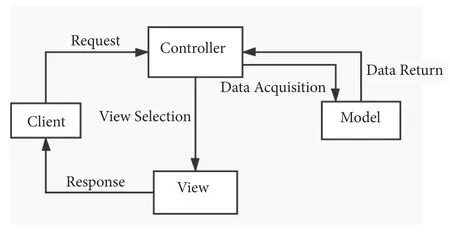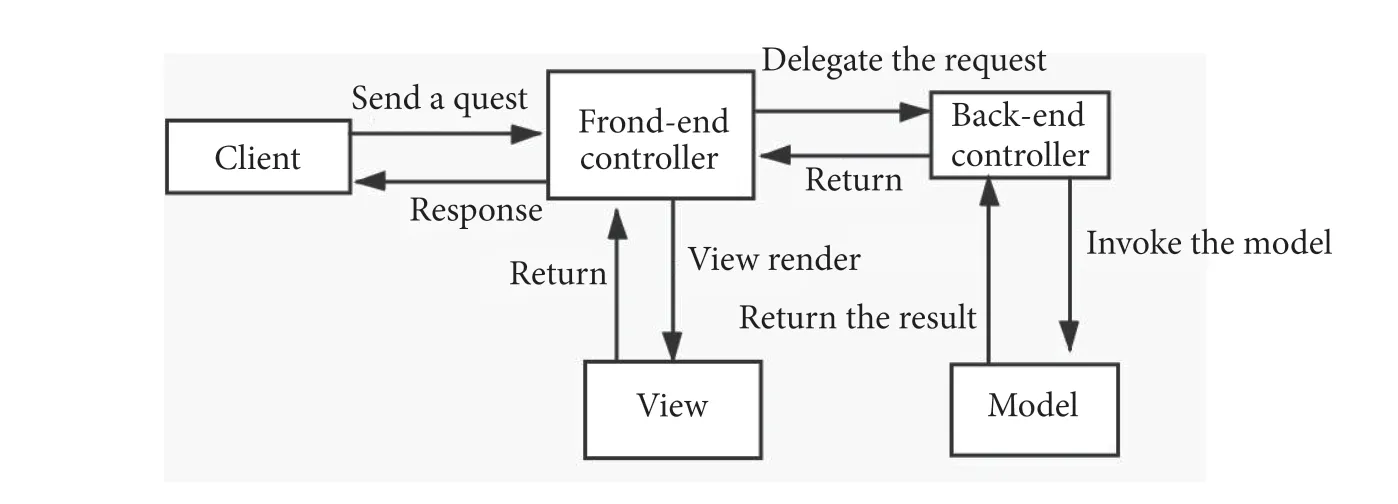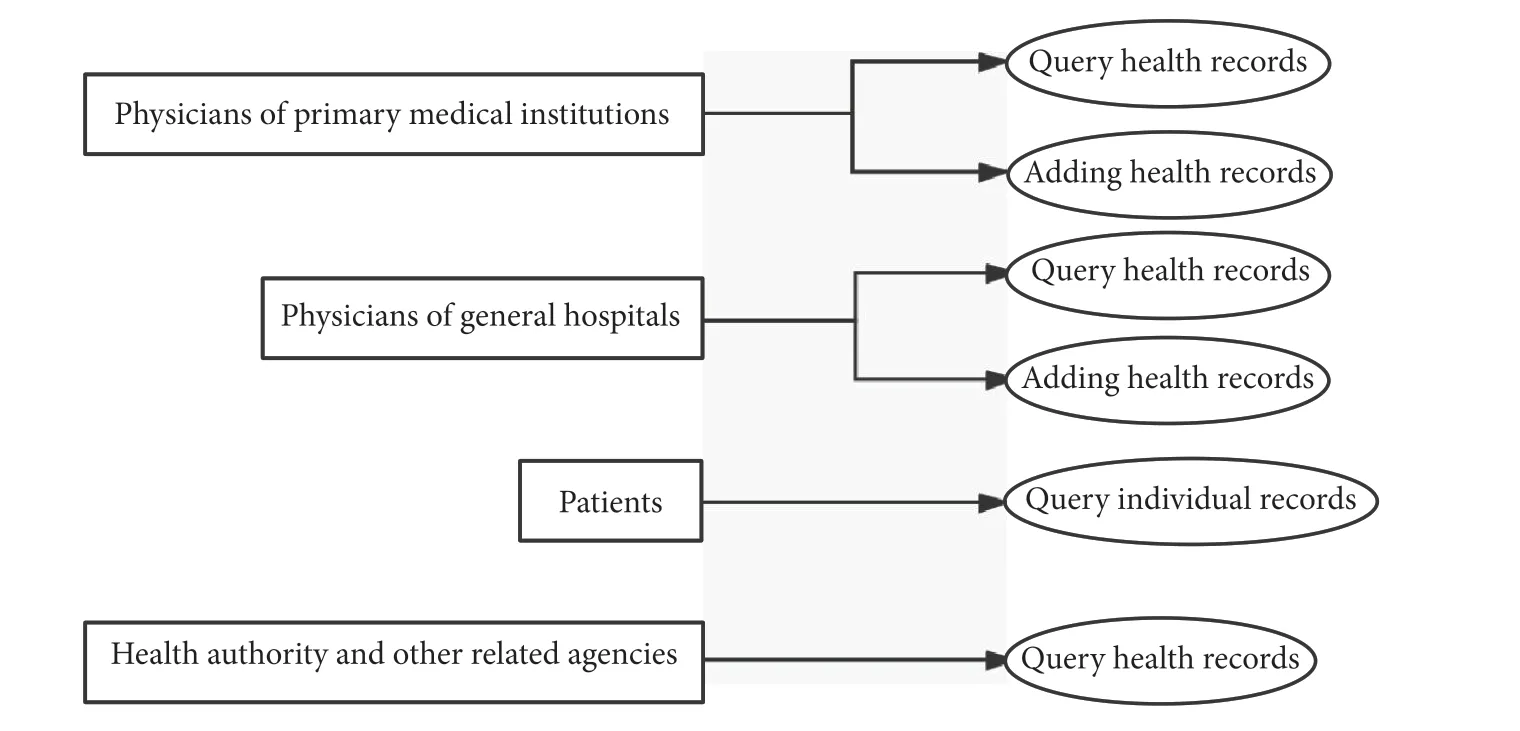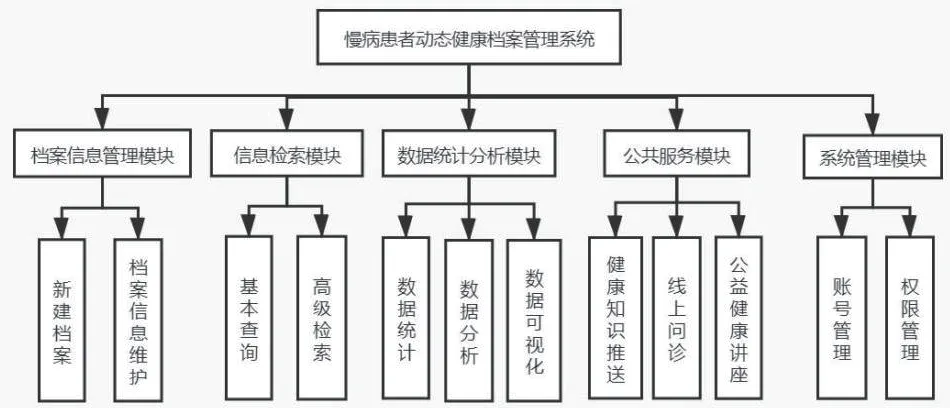Design of a dynamic health record management system of chronic patients based on regional medical consortium
2020-12-09CaoJilongYanYufang
Cao Ji-long, Yan Yu-fang
1 Information Center of the Fourth Affiliated Hospital of China Medical University, Shenyang 110032,Liaoning Province, China
2 Shenyang Institute of Computing Technology, Chinese Academy of Sciences, Shenyang 110168,Liaoning Province, China
Abstract As the national promotion of medical consortium construction, dynamic health records have been applied in the management of health records of patients with chronic diseases, as a novel medical information management approach. In order to facilitate the management of health records among chronic disease patients by medical institutions under the supervision of regional medical consortium in Huanggu District of Shenyang City, through investigation and research on medical institutions within the medical consortium, using MVC architecture model combined with data analysis and data encryption technology, a dynamic health record management system of patients with chronic diseases based on regional medical consortium is designed and implemented. We analyze the functional requirements of the system, study the goals of data analysis, and consider the security of data sharing. The system realizes the establishment and maintenance of health records, information retrieval, data analysis and public services among medical institution within regional medical consortium.
Key words: regional medical consortium; dynamic health records; data analysis; data encryption
Introduction
Background of system development
With the rapid development of information technology,the trend of informatization is increasingly required in all fields. The informatization of dynamic health records of chronic patients has become an inevitable choice for health record management[1], which conforms to the trend of our times and brings benefit to the hospital staff.The traditional health record management pattern mainly relies on the staff to manually complete the file recording and management, which produces low efficiency, timeconsuming and high cost of patient’s information retrieval, storage and maintenance, resulting in extremely inconvenient use and management of health records.
At the same time, Li Ke-qiang, Premier of the State Council, has proposed to deploy and promote the construction of medical consortium, deepen the reform of the system to provide convenient medical services for the masses, in the State Council Executive Meeting[2]. Under the traditional medical model, data between different health departments is not interoperable, health records of patients with chronic diseases are not timely updated,accompanied by inconsistent records and unavailability of data.
In order to adapt to the development of the times, respond to the call for reform of the medical system, and promote the construction of medical consortium, an uniform and efficient management of health records of chronic disease patients may simultaneously be convenient for medical staff to query the patients’ past medical records,so that medical institutions can share the data in real time manner, and guarantee for hierarchical diagnosis and treatment and two-way referral is ensured. Therefore, it is of practical significance and application value to develop a dynamic health record management system of patients with chronic diseases while meeting actual work needs.
Goal and significance of system design
The dynamic health record management system of chronic disease patients is a software responsible for managing the health information of chronic disease patients. It records the general information, medical visits, diagnosis and treatment of chronic disease patients, and achieves the goal of dynamically updating health information of chronic disease patients. It realizes the real-time sharing of health information among medical institutions within the medical consortium, promotes the exchange of information at the medical consortium region, and effectively avoids repeated examinations and treatments provided for patients, also reduce financial expenditure of patients. The system will record each of health change during the life of patients with chronic diseases. The system information is detailed and reliable. To a certain extent, it provides substantial assistance and reference for physicians to formulate diagnosis and treatment regimens,and helps physicians understand the patient’s health information, such as previous visits, health condition,and diagnosis and treatment regimens. Therefore medical institutions within the medical consortium region are enable to provide continuous, complete and systematic treatment regimens for patients with chronic diseases.
Key Techniques
System design pattern
In order to ensure the scalability and maintainability of the dynamic health record management system of patients with chronic diseases, the system is developed using the MVC three-tier architecture model. The MVC model is an advanced service design model[3],M referring to the Model is the most important part of the system, responsible for data management, that is,managing the back-end database of storing and saving the health information of patients with chronic diseases; V referring to the View is the front-end interface displayed to users, responsible for data display, that is, presenting the health information of patients with chronic diseases in the database and the results of data analysis on the browser page; C referring to the Controller is responsible for business logic and response strategies, mainly involved in responding to client requests and performing corresponding operations on the database according to user needs.
The interactive process of the system in MVC model is shown in Figure 1 below.

Figure 1 MVC architecture diagram
The working process of the system in MVC model is summarized as follows: the client sends a request to the front-end controller, the front-end controller receives the request and delegates the request to the backend controller for processing, the back-end controller processes the corresponding request by invoking the model and returns the requested result to the front-end controller, the front-end controller then renders the result through the view and finally responds to the client. The flowchart of the process is as follows:

Figure 2 MVC working process diagram
The MVC design pattern has the characteristics of low coupling, fast deployment, and high maintainability. In this design pattern, the system organizes the code by using the presentation layer, business logic layer and data layer, separately, indicating a good scalability. A model of multiple views and independent work process is realized,which improves code reusability and reduces the difficulty of system maintenance[4].
Database technique
The dynamic health record management system of chronic disease patients uses MySQL database to manage user data.MySQL database is one of the most popular databases used for website design. This database is a small- and medium-sized relational database. It has the characteristics of small size, fast speed, low cost and open access[5], and has been preferred in many system products during the establishment process. According to the relationship of the data in health information of patients with chronic diseases, this database assigns the data into different tables designed, so as to facilitate the system operations of the data in tables.
Data analysis technique
Data analysis technique refers to the techniques responsible for the reading, storage, calculation,visualization, analysis of the collected data related to the health of patients with chronic diseases[6]. On one hand,according to the data in the patient’s health records, the relevant factors that cause the disease are analyzed[7],to obtain the implicit and helpful information for the physician’s diagnosis, and accordingly assist the treatment of chronic diseases, it improves the accuracy and treatment effect to a certain extent. On the other hand, the patient’s health information is visually analyzed, and the visualization technology in data analysis is used to display the analysis results in more vivid and intuitive manner, the underlying laws in the data are analyzed to provide more reference for the diagnosis and further improve the overall medical level with regional medical consortium.
Data encryption technique
Data encryption technique is one of the key technologies to ensure data security in the system. It converts the health information of patients with chronic diseases in the system into meaningless cipher texts through keys and enciphering functions. Using this technique, the recipient of health information can recover the cipher texts to leartext through decryption key or decryption function[8]. The system adopts an advanced encryption algorithm using aggregated key to control the user’s read and access authority targeting the data in the system, and an improved attribute-based signature is applied to realize the user’s write authority[9], thus realizing the protection of the data in the system.
System Requirements Analysis
Analysis on the overall target requirements of the system
Through the investigation and research of the system serving the medical industry, a dynamic health record management system of chronic disease patient should achieve the following goals: clear system functions; elegant interface; strong operability; high safety; good stability;expandability.
Among them, ensuring the security of the system is an extremely important requirement in the information management system. All users in regional medical consortium who are eligible for using dynamic health record management system of chronic disease patients have access to query and add the individual health information of chronic disease patients in the system at any time,thereby realizing the sharing of health information within the regional medical consortium. In order to ensure the security of the system and prevent malicious attacks on the data in the system or the leakage of individual information of patients with chronic diseases, many approaches such as firewalls, data backup and data encryption must be employed to ensure that the information of patients in the system is complete without loss and privacy without leakage.
The stability of the system means that the system is able to withstand the pressure caused by simultaneous use from a large number of users. It is inevitable that multiple medical institutions within regional medical consortium will simultaneously use the system, which raises the stability requirement of the system. The system must be able to provide normal services for multiple users simultaneously.
The expandability of the system means that when the addition of new functions is required in the system, simple operation by adding on the original basis is ensured,without any major change of original code, the system design shall adhere to the open-closed principle, so that the system can be timely upgraded and maintained.
Analysis on user’s requirements
The dynamic health record management system of patients with chronic diseases is designed to provide convenience for all relevant staff in the medical consortium. After investigation and statistics, the users of this management system are mainly classified as follows: individual patients,primary medical institutions, general hospitals, health authority and other related agencies.
Analysis on business requirements
The medical and health institutions within the regional medical consortium should be able to understand and master patient-related information by retrieving the patient’s health records, make more accurate diagnosis,prevent repeated examinations, and improve overall efficiency. At the same time, the relevant public service departments within the regional medical consortium should be able to provide corresponding health education to patients by understanding their physical conditions. The health authority should also be able to obtain residents’health information in more comprehensive and accurate manner, thus yielding accurate and powerful decisions.
Analysis on performance requirement
During the usage process in the system, it is necessary to ensure the security of health information of chronic disease patients stored in the back-end database of the system, and establish different access authorities for users of different roles, thus avoiding malicious attacks on the system. The authority corresponding to different user roles is shown in figure below. On the other hand, it is also necessary to ensure the consistency of the data. When the user’s health information is updated, relevant data at the corresponding level in the system should be updated in time, which can better reflect the practical value of the system.

Figure 3 Authority allocation
System Architecture Design
The software architecture of dynamic health record management system of chronic disease patient includes the presentation layer, the business layer, and the persistence layer in an order from top to bottom. The presentation layer is mainly composed of pages, which present the patient’s health information, data analysis results, and health knowledge push information on the system page.The business layer mainly completes the requests sent by users to the system, and contributes to the realization of specific functions in the system. The persistence layer is mainly composed of a database and various frameworks,which are used to perform corresponding operations on the data in the database. The system architecture is shown in figure below.

Figure 4 System architecture
Functional Module Design
Dynamic health record management system of chronic disease patients includes several functional modules as shown in figure below:

Figure 5 Functional modules
Dynamic health record information management module
The dynamic health record information management module is the basic and essential part of the dynamic health record management system of chronic disease patients. Dynamic health records mainly include basic individual information, health status, diagnosis and treatment information, family medical history and other information of patients with chronic diseases in the regional medical consortium. Each medical institution in the regional medical consortium can comprehensively understand the patient’s condition through the information in the patient’s health records, and the patients are also able to understand their own health changes based on the information in the system that is dynamically updated in chronological order of each medical visit.
Dynamic health record information retrieval module
The dynamic health record information retrieval module provides services for users in two ways: advanced retrieval and basic query, which is convenient for users of different roles to retrieve information efficiently, and it is also convenient for system design and maintenance.
Dynamic health record data statistical analysis module
The dynamic health record data statistical analysis module includes three parts: data statistics, data analysis and data visualization. The realization of this module relies on the dynamic health record information management module. Only after the data are stored to the back-end database in the system, the data-based analysis can be performed. First, a statistical integration of the data is performed, to extract the target data from the source data,then target data are subject to pre-processing operations such as the cleaning, integration, and reduction of target data; subsequently, the hidden information in data are exposed using data mining algorithms and presented to physicians through visualization technology, the process is shown in figure below. It enables physicians to understand the patient’s physical condition in more intuitive and comprehensive manner, so as to formulate more accurate medical regimens.

Figure 6 Data analysis process
Public service module
The public service module is designed to serve patients with chronic diseases. This module mainly includes the following parts: health knowledge push, online consultation, and public health lectures. Through checking the physical conditions of patients with chronic diseases in the medical consortium, targeted health knowledge and health lectures for the patient’s condition are provided to help improve the health of patients. At the same time,patients are allowed to conduct online consultations through the system, which is convenient for patients’medical visits and improves the efficiency of consultation.
System management module
The system management module mainly includes two parts: account management and authority management.The system provides functions such as new user registration and old user password reset. At the same time,there are different roles for users with different identities in the background of the system, so that each functional module provides users with corresponding services.
Conclusion
This system is based on a pilot project in Huanggu District of Shenyang City, Liaoning Province. It has constructed dynamic health records of nearly 90,000 patients with chronic disease, and completes the design of a dynamic health record management system of chronic disease patients based on the regional medical consortium. Through the docking of the system, the homogeneous management of the hospitals is realized,so that the regional medical consortium is able to share real-time information, thereby effectively assisting the implementation of graded diagnosis and treatment and two-way referral. At the same time, to a certain extent,it solves several problems in the original medical model due to no access of sharing information, such as repeated inspections, repeated services, and repeated charges, it also avoids repeated use of medical resources, improves the efficiency of medical staff, and facilitates patients’ medical treatment.
杂志排行
Global Smart Medicine的其它文章
- SWOT analysis of static data backup media
- Research and application of information extraction technology in clinical medical records
- Application based on integration platform and big data center
- Instructions for Authors Journal of Global Smart Medicine
- Practical exploration of artificial intelligence in the field of medical nursing care
- Discussion on Internet of Things communication technology and its general development trend
